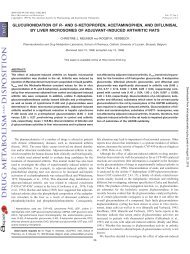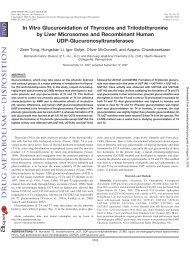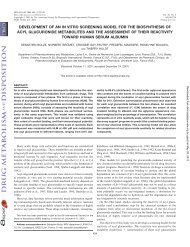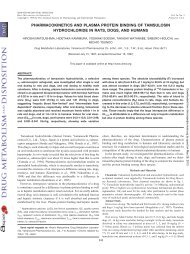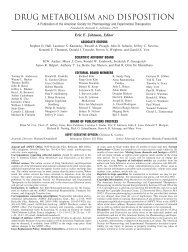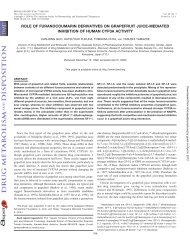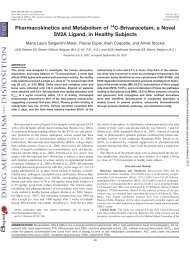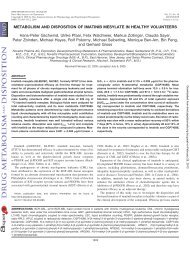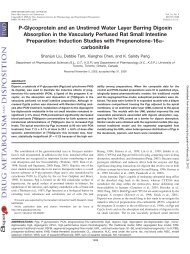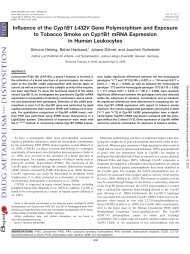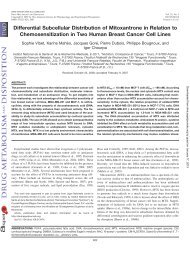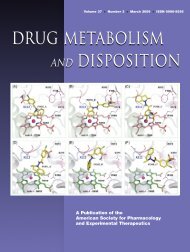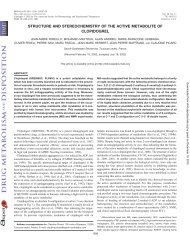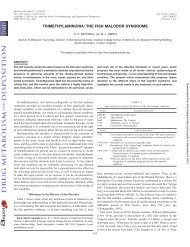metabolism of diallyl disulfide by human liver microsomal ...
metabolism of diallyl disulfide by human liver microsomal ...
metabolism of diallyl disulfide by human liver microsomal ...
You also want an ePaper? Increase the reach of your titles
YUMPU automatically turns print PDFs into web optimized ePapers that Google loves.
838 TEYSSIER ET AL.<br />
FIG. 2.HPLC pr<strong>of</strong>ile <strong>of</strong> an incubation <strong>of</strong> DADS with microsomes and NADPH,<br />
obtained with UV detection at 254 nm.<br />
If DADSO2 has been formed, its elution would be between the peak <strong>of</strong> NADPH<br />
(AU � 0.03) and the peak <strong>of</strong> DADSO.<br />
FIG. 3.Effects <strong>of</strong> 1-aminobenzotriazole on DADS oxidase activity.<br />
Values are mean <strong>of</strong> four samples � S.E.M. and are expressed relative to control<br />
(without inhibitor).<br />
TABLE 3<br />
Effect <strong>of</strong> thermal treatment <strong>of</strong> microsomes on few activities<br />
Values are the means <strong>of</strong> five determinations � S.E.M.<br />
CYP DADS a Oxidase MMO b<br />
ECOD b<br />
10 min 37°C 20.0 � 6.3 40.2 � 9.6 0.25 � 0.0<br />
Control 23.0 � 7.4 194 � 50.1 0.25 � 0.0<br />
a pmol/min/pmol CYP<br />
b nmol/min/mg protein<br />
tor), 2) microsomes containing irreversibly inactivated FMOs (this FMO<br />
inactivation is produced <strong>by</strong> heating the microsomes, Grothusen et al.,<br />
1996); the results indicated that FMO inactivation <strong>by</strong> heat treatment<br />
caused a 13% decrease <strong>of</strong> DADS oxidation (Table 3); it was verified that<br />
this thermal treatment inactivated the FMOs <strong>by</strong> measure <strong>of</strong> MMO activity<br />
although residual MMO activity was observed after 10 min heating;<br />
this was due to the CYP ability to metabolize the methimazole (results not<br />
shown and Poulsen et al., 1974); we checked also that thermal inactivation<br />
did not modify the ECOD activity; this reaction is <strong>of</strong>ten used as a<br />
standard marker for CYP-mediated reactions as several forms <strong>of</strong> CYP are<br />
involved in this activity), and 3) microsomes prepared from baculovirusinfected<br />
insect cell lines expressing the <strong>human</strong> FMO3 (in this medium,<br />
the same product DADSO was obtained as with <strong>human</strong> <strong>liver</strong> microsomes;<br />
the kinetic parameters <strong>of</strong> the reaction were calculated: K m �<br />
10.15 mM and V max � 41.9 pmol/min/pmol FMO3).<br />
Effect <strong>of</strong> Human CYP Inhibitors on DADS Oxidation. To further<br />
assess which CYP isoenzymes are involved in DADS oxidation,<br />
the effects <strong>of</strong> the following chemical inhibitors were determined:<br />
�-naphth<strong>of</strong>lavone (specific <strong>of</strong> CYP1A), chlorzoxazone (CYP2E1;<br />
Amet et al., 1995), coumarin (CYP2A6; Harris et al., 1994), diethyldithiocarbamate<br />
(CYP2E1; Guengerich et al., 1991), mephenytoin<br />
(CYP2C19; Harris et al., 1994), nifedipine (CYP3A4; Harris et al.,<br />
1994), orphenadrine (CYP2B6; Chang et al., 1993), quinidine<br />
(CYP2D6; Harris et al., 1994), sulfaphenazole (CYP2C9; Baldwin et<br />
al., 1995), tolbutamide (CYP2C9; Harris et al., 1994), tranylcypromine<br />
(CYP2C19; Postlind et al., 1998), and troleandomycin<br />
(CYP3A4; Rodrigues, 1994).<br />
The results are presented in Fig. 4. The strongest inhibitions were<br />
observed in the presence <strong>of</strong> diethyldithiocarbamate, followed <strong>by</strong> tranylcypromine.<br />
A slighter inhibition rate appeared with coumarin,<br />
chlorzoxazone, mephenytoin, nifedipine, and sulfaphenazole. Orphenadrine,<br />
tolbutamide, and troleandomycin had almost no effect on<br />
the DADSO formation, and �-naphth<strong>of</strong>lavone and quinidine had no<br />
effect at all. To verify the selectivity <strong>of</strong> some <strong>of</strong> the inhibitors used,<br />
we measured PNPH activity, a marker <strong>of</strong> CYP2E1, in the presence <strong>of</strong><br />
30 �M tranylcypromine, or <strong>of</strong> 22 or 200 �M coumarin. The result is<br />
shown in Table 4. Tranylcypromine and coumarin, described as<br />
selective inhibitors <strong>of</strong> CYP2C19 and CYP2A6 respectively, were also<br />
inhibitors <strong>of</strong> PNPH activity. These results suggest that tranylcypromine<br />
and coumarin can inhibit other CYPs, at least CYP2E1.<br />
Metabolism <strong>by</strong> Microsomes Containing cDNA-Expressed<br />
CYPs. The abilities <strong>of</strong> different <strong>human</strong> CYP enzymes to catalyze the<br />
S-oxidation <strong>of</strong> DADS to DADSO were investigated in many microsomes<br />
derived from cells expressing CYP DNA. CYP2A6, CYP2C8,<br />
CYP2C9, CYP2C19, CYP2D6, and CYP2E1 catalyzed the S-oxidation<br />
<strong>of</strong> DADS. CYP2D6, CYP2C19, and CYP2E1 were the most<br />
active enzymes. We can observe in Fig. 5, that every CYP is<strong>of</strong>orm<br />
followed a Michaelis-Menten kinetic except CYP2E1. For this latter<br />
enzyme, the DADS oxidase activity decreased quickly as soon as a<br />
certain amount <strong>of</strong> DADSO was produced. This could be explained <strong>by</strong><br />
the CYP2E1 mechanism-based inhibitor property <strong>of</strong> DADSO. No<br />
detectable amounts <strong>of</strong> DADSO were found when using microsomes<br />
expressing CYP1A2, CYP3A4, or CYP4A11, or when using microsomes<br />
from B-lymphoblastoid cells transfected with an empty vector.<br />
The kinetic parameters were determined for CYP2A6, CYP2C8,<br />
CYP2C9, CYP2C19, CYP2D6, and CYP2E1 (Table 5). CYP2E1<br />
exhibited the smallest K m whereas CYP2D6, CYP2C19, and CYP2E1<br />
had close V max values. The intrinsic clearance (V max/K m ratio) was<br />
2010 for CYP2E1 whereas it reached the maximum value <strong>of</strong> 108 for<br />
the other CYPs (Table 5).<br />
Correlation Study between DADS Oxidation and Specific CYP<br />
Activities. The correlation between DADS oxidation and CYP marker<br />
activities was analyzed with a panel <strong>of</strong> at least 24 individual samples<br />
<strong>of</strong> <strong>human</strong> <strong>liver</strong> microsomes. The characteristic transformations <strong>by</strong><br />
individual CYPs were EROD for CYP1A2, COH for CYP2A6, TDH<br />
for CYP2C9, MpH for CYP2C19, DOD for CYP2D6, (�-1)LAH and<br />
PNPH for CYP2E1, NfO for CYP3A4, and (�)LAH for CYP4A.<br />
These results are shown in Table 6. The best correlations (r) were<br />
found with PNPH, TDH, and (�-1)LAH activities, whereas the correlations<br />
with EROD, COH, DOD, NfO, MpH, and (�)LAH were<br />
very low.<br />
Downloaded from<br />
dmd.aspetjournals.org <strong>by</strong> guest on November 24, 2012



